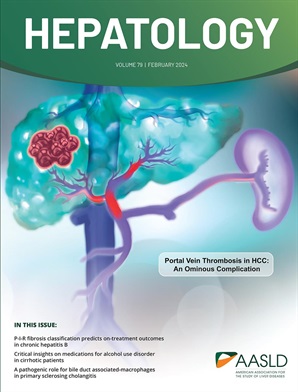Liver resection with and without vascular resection versus transplantation for de novo perihilar cholangiocarcinoma
IF 12.9
1区 医学
Q1 GASTROENTEROLOGY & HEPATOLOGY
引用次数: 0
Abstract
Background & Aims: The optimal treatment strategy for de novo pCCA remains debated. This study compares outcomes between liver transplantation following neoadjuvant chemoradiation (RT+LT) and liver resection (LR), with (LR+VR) and without vascular resection (LR w/o VR). Methods: This single-center, retrospective study included de novo pCCA patients treated at Mayo Clinic Rochester (1993-2023) with curative-intent surgery. Patients underwent either (1) LR, classified as LR+VR or LR w/o VR, or (2) RT+LT following the transplant protocol. Overall survival (OS) and recurrence-free survival (RFS) were analyzed using as-treated (AT) and intention-to-treat (ITT) approaches, incorporating competing risk analysis and direct matching. Results: In the AT analysis, RT+LT showed superior median OS compared to LR w/o VR (78.0 vs. 58.2 mo,肝切除加和不加血管切除与肝移植治疗新生肝门周围胆管癌的比较
背景,目的:新发pCCA的最佳治疗策略仍存在争议。本研究比较了新辅助放化疗后肝移植(RT+LT)和肝切除(LR+VR)和不切除血管(LR /o VR)的结果。方法:这项单中心、回顾性研究纳入了在罗切斯特梅奥诊所(1993-2023)接受治疗目的手术的新发pCCA患者。患者接受(1)LR,分为LR+VR或LR / 0 VR,或(2)移植方案下的RT+LT。总生存期(OS)和无复发生存期(RFS)采用治疗状态(AT)和意向治疗(ITT)方法进行分析,包括竞争风险分析和直接匹配。结果:在AT分析中,RT+LT的中位OS优于LR /o VR (78.0 vs. 58.2个月,p=0.03)和LR+VR(25.8个月,p= 0.001)。考虑到辍学率(RT+LT: 41%, LR: 28%), ITT分析显示LR和RT+LT之间无显著OS差异(31.7 vs 38.5, p=0.19)。在匹配的AT分析中,RT+LT与LR(50.6个月vs. 140.6个月,p=0.08)或LR+VR(25.8个月,p=0.11)相比,生存率没有显著提高。围手术期死亡率分别为4% (RT+LT)、7% (LR+VR)和8% (LR+VR)。结论:在选定的新发pCCA患者中,LR和RT+LT均可获得良好的肿瘤预后。主要的挑战仍然是LT患者在新辅助治疗期间的退出和LR患者的高围手术期死亡率。与退出患者相比,LR+VR患者的OS增加了一倍,支持LR+VR作为不符合lt的患者的可行选择。适当的病人选择是至关重要的,因为那些不接受手术的人预后很差。
本文章由计算机程序翻译,如有差异,请以英文原文为准。
求助全文
约1分钟内获得全文
求助全文
来源期刊

Hepatology
医学-胃肠肝病学
CiteScore
27.50
自引率
3.70%
发文量
609
审稿时长
1 months
期刊介绍:
HEPATOLOGY is recognized as the leading publication in the field of liver disease. It features original, peer-reviewed articles covering various aspects of liver structure, function, and disease. The journal's distinguished Editorial Board carefully selects the best articles each month, focusing on topics including immunology, chronic hepatitis, viral hepatitis, cirrhosis, genetic and metabolic liver diseases, liver cancer, and drug metabolism.
 求助内容:
求助内容: 应助结果提醒方式:
应助结果提醒方式:


